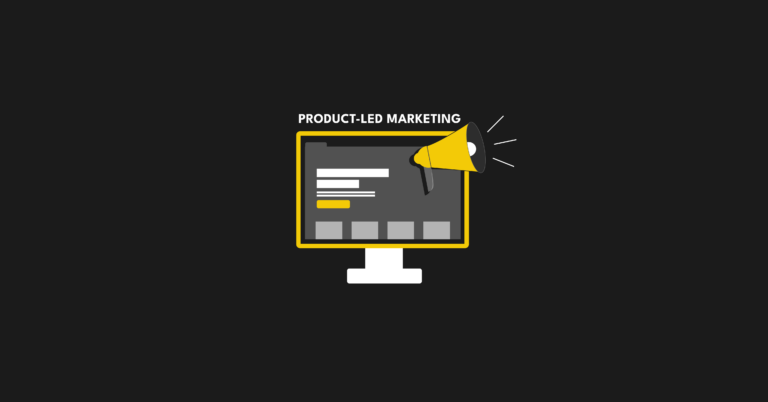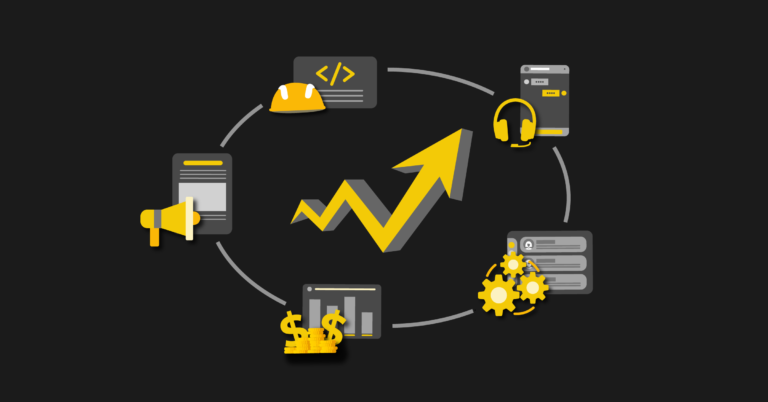Building a product growth team structure is an invaluable asset to finding new and creative solutions for growth, being on top of product development and innovation within the company, and moving fast.
In my 6 years as a service and product manager with 7shifts, I’ve been able to drive experimental growth on existing products, take new product ideas to market, and much more – all thanks to our product growth team.
This article will touch on two main points: how to advocate for these teams and how to grow them.
I’ll answer these questions:
- What is product growth?
- What is a product growth team?
- How do you advocate for a product growth team?
- implementing a product growth team
- Who shold be on the team?
I’ll then end things off with my top tips to help on your journey.
What is product growth?
At 7shifts, we’re trusted by more than 350,000 restaurants around the world, including top brands like Five Guys, Bareburger, and more. In a nutshell, 7shifts helps restaurants simplify their labor management by providing them with scheduling and management services.
The function of the product growth team is to bring new products and offerings to market, as well as improve on existing ones.
This includes all sides of the product: the technical aspect, CX design, new opportunities to expand our market, along with working to improve every aspect of our current product.
What is a product growth team?
There are so many different definitions, applications, and responsibilities of a product growth team that there’s no really good single definition.
But let’s take a crack at it.
A product growth team is the team responsible for prioritizing product experiments such as developments and acquisitions to grow your top-line revenue. You do this by automating as much of your revenue generation as possible across every step of the customer lifecycle.

At 7shifts, we called our product growth team the “lifecycle team.” That’s because this team monitors the pulse of the customer.
This team has the knowledge of products and customers and a connection to every department so they can help identify gaps and opportunities for the business.
With a product-led business, lead qualification is important when thinking about how to grow a product growth team.
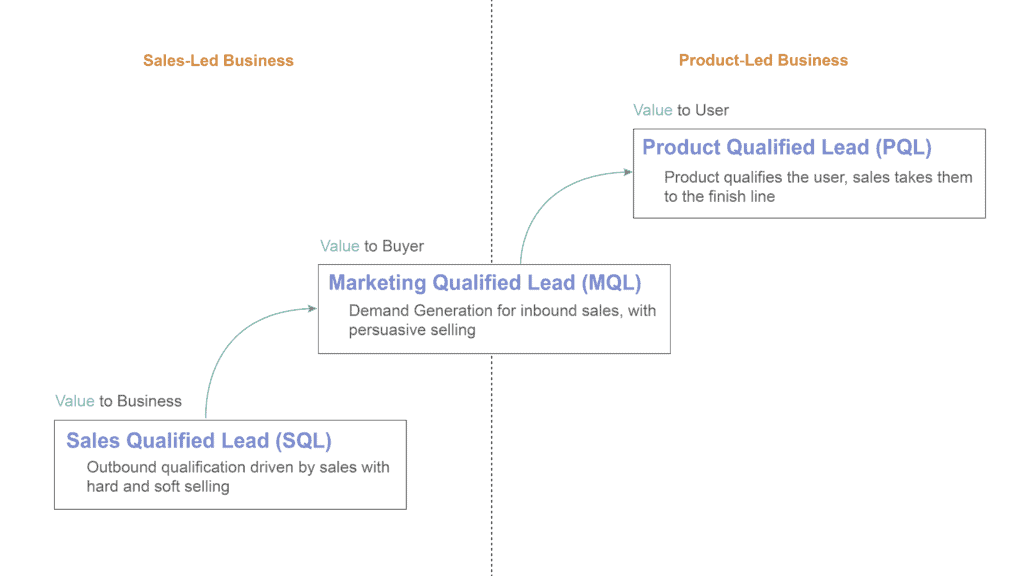
At 7shifts, we’re a product-led business, but sales-led businesses can still have a product growth team (though sales-led businesses focus less on the value to the customer and more on the value to the business).
How do you advocate for a product growth team?
You need to rigorously advocate for the implementation of this team because it’s not one that will form overnight, nor will it be easy.
There are six steps to advocate for your product growth team:
- Build a story
- Put together a coalition of dedicated people
- Get buy-in from the top
- Get buy-in from other teams
- Get buy-in again (it doesn’t stop)
- Show the value
Let’s see what each of these steps looks like so that you can effectively advocate for your own.
Step 1: Build a story
There’s the old saying... “build it, and they will come.”
In our experience, that’s actually pretty accurate.
Before you start putting together a coalition of individuals behind this team, you have to build the story.
This story must be an understanding of what the goals, activities, benefits, and agenda of the product growth team will be. You need to understand who will be involved and what metrics tie into the growth of your revenue.
Step 2: Put together a coalition of dedicated people
This step is all about finding people who support your idea.
If you start at the ground level, you need a team of people who will push your story and push forward your agenda. This means identifying the department that has direct growth targets related to revenue and identifying them as the key to success.
This group will show that you want to build this team within the organization and that it’s a good idea to do so.
Step 3: Start at the top
Once you have your story and a team of dedicated supporters, it’s time to start from the top. This is the first “buy-in” step of our process – it starts with executives.
If you’re a small business, that could be a simple process of talking to the CEO, COO, or founder of the business. With larger businesses, you want to start with executive buy-in as high as you can get.
The goal is to start with one executive sponsor who really supports your idea.
Once you’ve created that relationship, relentlessly work with that executive to build the shared mindset of product growth. If the mindset starts with executives, and they see why this team is so important, implementing it will be much easier, and you’ll encounter less resistance along the way.
So how can you get their buy-in?
Speak their language.
Most executives, no matter where you are, speak two languages.
Data and money.
If you speak one of these languages and discuss the raw data that shows how this team will work to make them money, it’s pretty hard to argue with.
At 7shifts, I saw a huge opportunity to make more money with our initial sign-up flow with raw data.
For you, this could be as simple as saying that, “if we were to improve X, then we will see great growth in our MRR.”
Or it could be, “I’ve looked at our past data performance, and if we do Y, we’re going to solve a lot of inefficiencies and make our customers happier.”
Step 4: More buy-ins
Now that you’ve got buy-in from the top, work your way down and get more people in on the idea.
The next teams you want to focus on are sales and marketing.
Buy-in from these teams should focus on dispelling two key myths.
- The first myth is that you’re replacing them. This couldn’t be further from the truth. The product growth team is meant to complement the marketing and sales teams and actually amplify and improve their core functions.
- The second myth is that the product growth team will be a closed-off team that only works with the executives. The team is meant to connect sticking points and areas where there may be gaps because other departments aren’t collaborating and communicating.
All in all, the product growth team is meant to be a support team to communicate and work with marketing and sales – to give them insights, data, and other tools to help better reach customers.
Step 5: Even more buy-ins
By this point, you can probably tell that getting buy-in for a product growth team across an entire organization is important.
Once marketing and sales are on board, you really want to focus on product and engineering teams. This, of course, may look very different from one company to another (you may not even have these teams).
But for a product-led organization, chances are you have some sort of digital engineering team that works in the background to design and develop products.
To better get the buy-in from these teams, work around milestones of growth.
Especially if you’re an earlier start-up, you’ll want to build buy-in milestones around funding, where teams can hire extra developers or receive extra support to build a more scalable and stable product.
This allows you to keep growing and allows these teams to create more stable code.
Step 6: Prove the value
The last step in the process of building advocacy for your product growth team is to prove the value.
If you’ve completed other steps right, this should be simple. Other teams and executives should already have a good idea of the huge value this team will bring.
The product growth team sits right on top of the customer lifecycle, and they’re plugged into every aspect of the process. This means that they should understand where the opportunities are and how to define them. Your role in providing value is to identify these opportunities and prove that you have the data to back them up.
This isn’t a quick process.
Providing and proving the value of the product growth team is important because you need to consistently find the data, analyze it, and prove the opportunities are real.
A product growth team doesn’t have to exist for you to take on these exercises. Start with your story, then build support.
If you can build a sturdy foundation on your own before needing all the support to help back you up, you’re going to have so much more success.
But, if you’re starting by yourself, you’re going to need to know how to implement a product growth team, which we’ll dive into next.
Implementing a product growth team
There are really three steps involved in implementing a product growth team.
- Look at guiding principles
- Prioritization of action
- Backlog management
Step 1: Guiding Principles
It may seem silly that you’ve just spent all this time planning and preparing either by yourself or with a team, and now you have to take a step back… again?
At this phase, this is actually really important.
That’s because you’ve just spent so much time preparing, planning, and proving the value of what you can do; it’s time to sit down as a team.
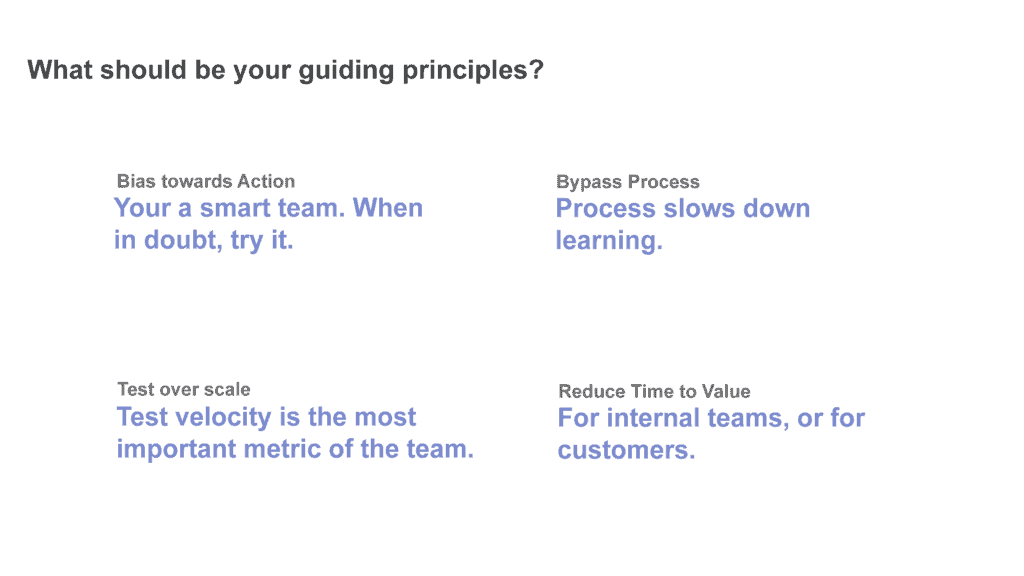
Your team will come together with different values and alignments. But at the end of the day, it’s important to meet and ensure you are all aligned with how you will make decisions and provide value.
For example, a key focus could be to reduce the time to value.
Step 2: Prioritization of action
Since your team sits right on top of the customer lifecycle, you can really pull almost any lever in the company. What I mean by “pull the lever” is that your team has to define where the most benefit and the greatest revenue impact will be realized in the customer lifecycle.
You have to ensure the whole team knows:
- What your priorities are
- Where you will act first
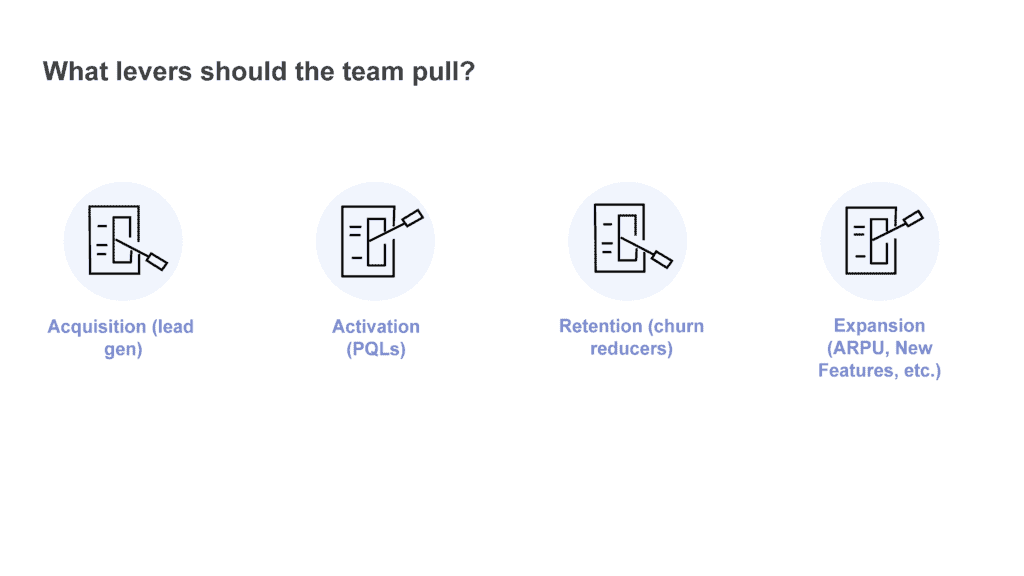
For example, at 7shifts, we focused on activation.
You have to find a middle ground where your data supports a certain prioritization, but that the prioritization of the team aligns with company objectives. In my experience, the best way to make sure you’re aligned is to prioritize using cascading objective key results (OKRs). It looks something like this.
Once you know this, you can tailor your prioritization to align with some of the key goals of the company.
Step 3: Backlog management
The last step in your implementation of the product growth team is backlog management.
Essentially, this team is responsible for the backlog of experiments. This could be new product acquisition, process developments, product growth, pulling new levers, or anything else within that customer lifecycle that can grow the business.
Once you’ve identified an experiment from your backlog that could prove successful, make it a provisional priority.
Create these backlogs by taking the priorities and goals you’ve identified, and then go to every team in the organization and ask them how they think you can improve certain processes.
After you receive this feedback, there will be hundreds of ideas in the backlog.
The best ways that I’ve found to manage backlog in my experience come down to five tasks.
1. Use simple scoring and themes.
Make a scale and small groups of items. Then, rank each item and thematically sort groups to understand what you should be working on first.
2. Phrase items as hypotheses, not as solutions
If you phrase everything as a solution, it will be much easier to come back to this massive list of backlogged items and understand what you were trying to accomplish.
If you have external stakeholders like executives also looking at your backlog list, it makes it easier for them to see that you don’t have a list of solutions but rather a list of potential solutions you are testing.
3. Make quick designs for each hypothesis
You can make short, 15-minutes designs for each hypothesis as a wireframe to illustrate and visualize what you’re thinking about and what a potential solution would look like in action.
4. Provide visibility and reasoning
Providing reasoning and visibility to prioritized and deprioritized items is one of the most important ways to manage your backlog.
The external stakeholders to your team are fundamental to the idea generation of experiments that you’ll run. You really want to visualize and provide reasoning as to why certain ideas were prioritized or deprioritized to make sure no one is discouraged and that everyone feels encouraged to work and communicate with the team.
5. Build a consistent structure
Make sure that you have prioritization, hypotheses, designs, visibility, and action steps for each backlog item to make it easy to scan and to make sure it’s a useful tool.
Once you’ve done all that, what will your backlog management look like once it's in action? This is the type of test backlog framework that we built for our team because it allowed us to move fast and yield actionable results.
We run different types of tests that work fast, and we actually didn’t run A/B tests for everything. These take so much time, so we would sometimes run uncontrolled tests, smoke tests, and other types of tests to measure hypotheses.
But once you create your management matrix as we have here, you’ll be able to simple and efficiently manage your backlogs.
Who should be on the team?
The product growth team is unlike most others.
It’s not about people.
Most teams in a business are a blend of people and skills because you want to make sure that people can work together and align together as individuals. It can be boiled down to these key positions:
- The driver
- Marketer
- Code writers
- Designers
- Statisticians
Position 1: The Driver
The driver is the person who leads the team.
They are data-driven with a strong product management background and skill-set that can set the cadence for the team.
The driver needs to have really good decision-making and prioritization skills to be able to lead the team in the right direction.
They should be able to manage, document, and help all processes move forward while managing it all at once.
Position 2: Marketers
You need a marketer. This person is data-driven with product marketing experience, but ultimately they need to be able to wear lots of different hats in this role.
They need to be able to understand branding, copywriting, customer messaging, web design, social media, and marketing requirements throughout every part of the customer lifecycle.
Position 3: Code writers
Without someone writing code, you’re not going anywhere.
Ideally, you have two to three developers on the team, and they should focus on where customers pay you.
For example, if you have a mobile app that drives more sales, put two developers there. Have one in the background on the web to ensure the web platform and the other to ensure the process of the customer lifecycle is optimized.
Avoid developers who lean towards architecting systems for scale.
On this team, you want to move fast, so you want developers that are okay throwing away work. You need developers who have a wide set of skills and can move really quickly and build hypotheses.
Position 4: Designers
You need designers with a CX and UX mindset who understand user friction, what customers want to see, and how they use your products.
They need to see more than a nice website that looks beautiful.
The designers are responsible for creating and designing functional and intuitive experiences for customers at every step of the customer lifecycle.
Position 5: Statisticians
The last position you need is someone who can look at numbers, understand data, interpret this data, and validate hypotheses through data-driven analysis.
They need to have a strong background in A/B test analysis and SQL test analysis and really understand how data drives results.
Once you’ve got a strong statistician, never let them go because they’re an invaluable member of the team to really provide that data.
If you can have at least one person to fulfill each of these skills (it could be one person, or it could be more), then you have a very high likelihood of success.
Growth Team Structure Tips
I’ve compiled a list of the top six tips I’ve learned in my career that will help implement, advocate for and grow in the future.
- It takes time
- Alignment
- Velocity experiments
- A culture of failure
- Velocity experiments
- A mindset of experimentation
Tip 1: It takes time
Buying in is the first step. But it takes lots of time, consistency, and perseverance to actually change processes.
You need to stick with it and remember it won’t happen overnight.
Tip 2: Alignment is critical
You need to make sure that your priorities and metrics are consistent.
For the team to be a success, you need to make sure all departments are aligned with critical metrics and that everyone knows what metrics and values are most important to be deemed a “success.”
Tip 3: Velocity experiments
Consistently using velocity experiments is the best leading indicator of success for a product growth team.
Tip 4: Build a culture of failure
You need to remember to fail forward.
Embrace a culture of failure. This means that you need to view failure as a learning experience and understand that most of your experiments and backlogs may not work in the first place.
But take those failures and learn from them.
That’s how you’ll see the best growth.
Tip 5: Start small, then scale
Don’t try to get big right away.
Remember that it not only takes time, but you’ll start small.
So, be comfortable starting small and make iterations along the way, and iterate quickly. By doing this and remaining agile, you will be able to grow much faster and much more effectively.
You’ll also be able to become a well-oiled machine that just keeps churning out opportunities for the business.
Tip 6: Experimentation Mindset
You need to provide the tools, training, and strategies to all product teams in order to build an experimentation mindset.
You’ll be working fast, so you need to be communicative and collaborative to be successful.
At the end of the day, it’s important to start somewhere.
Whether it’s just you or it’s a team that is supporting you and helping you grow, the most important thing is to just find those priorities and goals and start somewhere.

